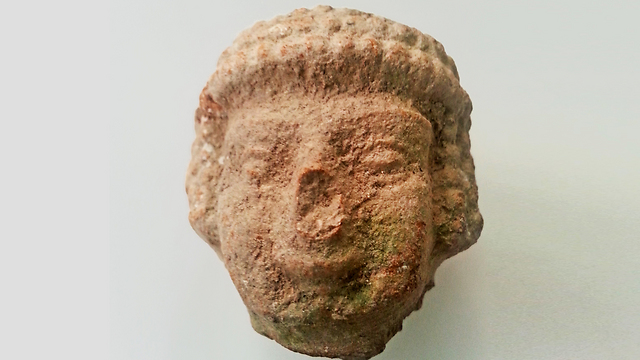
8-year-old Indiana Jones makes major archaeological discovery
Itay Halperin finds a statuette of a goddess of fertility from the 8th century BC at Tel Beit Shemesh; archaeologists say these figurines were common during the First Temple period.
While hiking with his family in Tel Beit Shemesh in the Shfela area (the lowlands of Judea), Itay noticed a round object on the ground.
When examining the object made of clay, he was surprised to see that it was the head of a statuette. The family rushed to report the interesting find to the Israel Antiquities Authority (IAA), whose members came to meet them there.
Alon de Groot, an IAA expert researching the Iron Age, identified the object as the head of a statue of a goddess of fertility. He said that "such figurines, in the form of a nude woman symbolizing fertility, were common in the homes of residents of the Kingdom of Judah from the 8th century BC to the destruction of the First Temple by the Babylonians in the days of Zedekiah (circa 586 BC)."
De Groot added that "these figurines are used in research as it is an item that identifies the area as controlled by the Kingdom of Judah."
Anna Eirich, an IAA archaeologist of the Judea District, said that "it is no coincidence that this statuette was discovered at the top of Tel Beit Shemesh, near a residential district from the First Temple period. Beit Shemesh is mentioned in the Bible as a city in the territory of the tribe of Judah.
"Every summer, excavations are carried out by Tel Aviv University, headed by Zvi Lederman and Shlomo Bunimovitz. These excavations find that during the First Temple there was a large city there, which served as a local industrial and commercial center. The city was surrounded by a wall that surrounded many residential buildings as well as public buildings, warehouses and a spectacular water mill. In 701 BC, Assyrian king Sennacherib destroyed Beit Shemesh, and the final destruction of the city took place in 586 BC by Nebuchadnezzar, king of Babylon."
Halperin, who recently saw the movie Indiana Jones, said he wanted to be like him when he grew up, so finding the figurine was a dream come true for him.
The IAI praised Itay for his being a good citizen as it is important to call archaeologists when the objet is still in the area it was found in to enable them to get the most accurate archaeological information possible.
Halperin will not be able to keep the statuette, but the IAA will give him a certificate of appreciation and his classmates will be invited to participate in an archaeological excavation with the IAA and and a tour of the archeological treasures of Israel.











